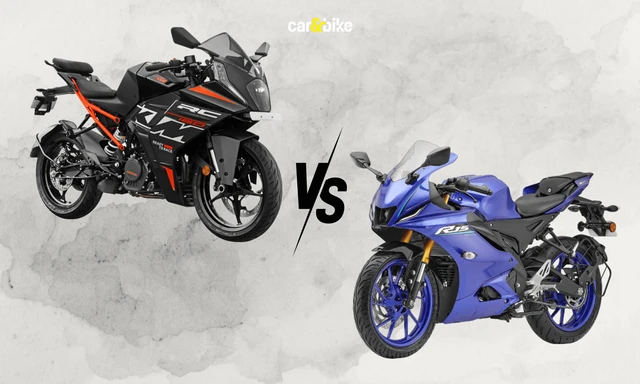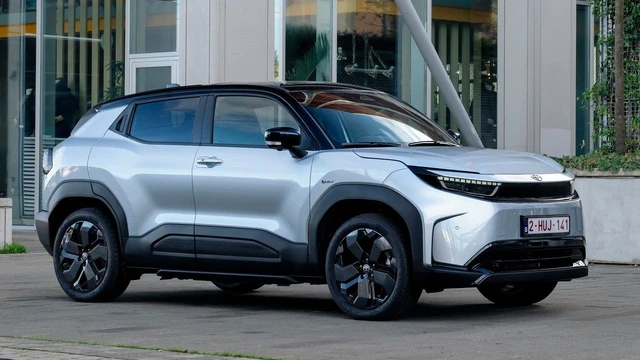2025 Bajaj Pulsar NS400Z: Differences Explained

- NS400Z gets updated powertrain with more performance
- New forged piston, optimised cam timing & intake duct
- More power, better acceleration, higher top speed claimed
The Bajaj Pulsar NS400Z, the flagship model in the Bajaj Pulsar range, has been comprehensively updated for 2025. Now priced at Rs 1.92 lakh, the changes to the motorcycle include a revised powertrain with more performance, a newly developed software-based quickshifter system, upgraded brakes, and more. With the changes in the powertrain, the Pulsar NS400Z is claimed to have better acceleration and top speed than before, as well as better stopping power. The upgrade to the Pulsar NS400Z comes just a year after the bike was launched in May 2024. Here’s all you need to know about the updates on the 2025 Bajaj Pulsar NS400Z.
Also Read: 2025 Bajaj Pulsar NS400Z Reaches Dealerships Ahead Of Launch
Engine & Powertrain
The 373 cc engine in the Pulsar NS400Z has been thoroughly revised
The single most important update to the 2025 Bajaj Pulsar NS400Z is in the engine and powertrain. The 373 cc, single-cylinder liquid-cooled engine has undergone significant updates, including a thoroughly revised valvetrain with optimised cam timing and revised intake ducts. The airbox remains the same, but the bottom end of the engine has also undergone changes with a Nikasil-coated forged piston replacing the earlier cast piston. The stronger forged piston is said to have better thermal efficiency as well as withstand higher performance better. With the changes in the powertrain, the radiator cowl has also been redesigned to direct heat flow away from the rider.
Also Read: Bajaj Pulsar NS400Z Real World Review
Performance
The Pulsar NS400Z's engine now churns up to 42.4 bhp, resulting in faster acceleration
In Sport mode, the updated Pulsar NS400Z now has an output of 42.4 bhp at 9,000 rpm, compared to the 39.4 bhp output it used to have earlier. Acceleration has also increased as a result of the updates to the powertrain. Acceleration time from 0-60 kmph is said to have increased by 0.5 seconds to 2.7 seconds, while 0-100 kmph acceleration time has increased by 0.9 seconds to 6.4 seconds. Top speed has also increased to 157 kmph on the updated model. Peak rpm has increased to 10,700 rpm in Sport mode and 10,300 rpm in Road mode.
Sport Shift “Quickshifter”
In collaboration with Bosch, Bajaj R&D has introduced a software-based quickshifter system which uses software and the gear position sensor to pre-empt shifts on the gearbox. According to Bajaj, the software-based quickshifter has been developed due to cost considerations. The quickshifter is offered only in Sport mode and has been termed the “Sport Shift” system. The Sport Shift system cannot be retro-fitted on previous generation Pulsar NS400Z models.
Brakes & Tyres
The motorcycle now gets sintered front brake pads
Going with feedback from multiple reviews of the outgoing model, the company has also replaced the front brake pads with sintered pads on the 2025 Pulsar NS400Z, which should give it better stopping power and braking performance. The 17-inch wheels are now shod with Apollo Alpha H1 radial tyres (110/70-ZR17 (F) and 150/60-ZR17 (R)). However, Bajaj has also stated that the motorcycle could also be offered with MRF tyres in case of supply constraints. As a result of the changes in the brakes and tyres, Bajaj says the stopping distance has reduced by 7 per cent. Existing customers can opt to replace the brake pads with sintered pads.
Price & Value
With the changes, prices for the 2025 Bajaj Pulsar NS400Z have increased by Rs. 8,000, which still makes it excellent value for money as a performance roadster at its price point. So far, the NS400Z has sold over 20,000 units and is a popular model in overseas markets, particularly in the Latin American region.
Average Volumes Per Month (AVPM) hit a high of 3,400 units in the domestic market and 3,700 units in overseas markets, making it a popular export model for Bajaj. In India, the Pulsar NS400Z has a long list of rivals, including the KTM 390 Duke, the Triumph Speed 400, the TVS Apache RTR 310, and its sibling, the Bajaj Dominar 400, as well as the Royal Enfield Guerrilla 450 to some extent. We will be test riding the 2025 Bajaj Pulsar NS400Z soon, so look out for our first impressions!
Latest News
 Jafar Rizvi | Jan 9, 2026KTM RC 160 vs Yamaha R15: Specifications, Features, Prices ComparedKTM’s new RC 160 goes head-to-head with the Yamaha R15 in the entry-level sportbike category. Here is how the two fare on paper.1 min read
Jafar Rizvi | Jan 9, 2026KTM RC 160 vs Yamaha R15: Specifications, Features, Prices ComparedKTM’s new RC 160 goes head-to-head with the Yamaha R15 in the entry-level sportbike category. Here is how the two fare on paper.1 min read Amaan Ahmed | Jan 9, 2026Suzuki E-Access Launched At Rs 1.88 Lakh; LFP Battery Promises 95 KM RangeOriginally confirmed for a June 2025 launch, Suzuki's first electric two-wheeler for India has finally arrived almost a year after making its global debut at Auto Expo 2025.3 mins read
Amaan Ahmed | Jan 9, 2026Suzuki E-Access Launched At Rs 1.88 Lakh; LFP Battery Promises 95 KM RangeOriginally confirmed for a June 2025 launch, Suzuki's first electric two-wheeler for India has finally arrived almost a year after making its global debut at Auto Expo 2025.3 mins read car&bike Team | Jan 9, 2026Kawasaki Ninja, Versys Models Offered With Discounts Of Up To Rs 2.50 LakhThe Ninja ZX-10R is offered with maximum benefits, followed by the Ninja 1100SX and Versys 1100.1 min read
car&bike Team | Jan 9, 2026Kawasaki Ninja, Versys Models Offered With Discounts Of Up To Rs 2.50 LakhThe Ninja ZX-10R is offered with maximum benefits, followed by the Ninja 1100SX and Versys 1100.1 min read Bilal Firfiray | Jan 9, 2026Toyota Urban Cruiser EV: What To ExpectToyota will be introducing an all-electric vehicle for the first time in India. It is the Toyota-badged version of the soon-to-be-launched Maruti Suzuki e-Vitara, and here’s everything we expect from it.1 min read
Bilal Firfiray | Jan 9, 2026Toyota Urban Cruiser EV: What To ExpectToyota will be introducing an all-electric vehicle for the first time in India. It is the Toyota-badged version of the soon-to-be-launched Maruti Suzuki e-Vitara, and here’s everything we expect from it.1 min read Jaiveer Mehra | Jan 8, 2026Auto Sales 2025: BMW Group India Sold 18,001 Cars And SUVs, Its Highest Ever Yearly FigureCarmaker delivered 17,271 units under the BMW brand and 730 units under Mini.1 min read
Jaiveer Mehra | Jan 8, 2026Auto Sales 2025: BMW Group India Sold 18,001 Cars And SUVs, Its Highest Ever Yearly FigureCarmaker delivered 17,271 units under the BMW brand and 730 units under Mini.1 min read car&bike Team | Jan 8, 2026Suzuki Motorcycle India Achieves 10 Million Production MilestoneThe 10 millionth unit was an Access 125 scooter, which rolled out from Suzuki’s Gurugram plant.1 min read
car&bike Team | Jan 8, 2026Suzuki Motorcycle India Achieves 10 Million Production MilestoneThe 10 millionth unit was an Access 125 scooter, which rolled out from Suzuki’s Gurugram plant.1 min read
 Bilal Firfiray | Jan 9, 2026Toyota Urban Cruiser Hyryder: 10,000 km Long-Term ReviewAfter spending over three months and 10,000 km with the Toyota Urban Cruiser Hyryder Hybrid, we were impressed by its real-world mileage, seamless hybrid, practical comfort, and Toyota reliability. Is it the best C-SUV then?5 mins read
Bilal Firfiray | Jan 9, 2026Toyota Urban Cruiser Hyryder: 10,000 km Long-Term ReviewAfter spending over three months and 10,000 km with the Toyota Urban Cruiser Hyryder Hybrid, we were impressed by its real-world mileage, seamless hybrid, practical comfort, and Toyota reliability. Is it the best C-SUV then?5 mins read Seshan Vijayraghvan | Jan 8, 20262026 Mahindra XUV 7XO Review: Big On Tech, Bigger On ComfortThe new Mahindra XUV 7XO is flashier, feature packed, and comes with more advanced tech. But are the changes just incremental or actually substantial?1 min read
Seshan Vijayraghvan | Jan 8, 20262026 Mahindra XUV 7XO Review: Big On Tech, Bigger On ComfortThe new Mahindra XUV 7XO is flashier, feature packed, and comes with more advanced tech. But are the changes just incremental or actually substantial?1 min read Preetam Bora | Jan 10, 2026Simple One Gen 2 First Ride Review: 265 km Claimed Range!The Gen 2 model of Simple Energy’s first electric scooter gets a fair few updates, including new features, tech, more range and lighter weight. We spent a couple of hours with the Simple One Gen 2 to find out if it manages to impress.6 mins read
Preetam Bora | Jan 10, 2026Simple One Gen 2 First Ride Review: 265 km Claimed Range!The Gen 2 model of Simple Energy’s first electric scooter gets a fair few updates, including new features, tech, more range and lighter weight. We spent a couple of hours with the Simple One Gen 2 to find out if it manages to impress.6 mins read Amaan Ahmed | Jan 3, 2026VLF Mobster 135 300 KM Review: Fun But FlawedA 125 cc scooter with Italian design and Chinese genes is a rare combination, and while some may be tempted to dismiss it because of its origins, the VLF Mobster shows 125s can also be exciting – but not without compromises.11 mins read
Amaan Ahmed | Jan 3, 2026VLF Mobster 135 300 KM Review: Fun But FlawedA 125 cc scooter with Italian design and Chinese genes is a rare combination, and while some may be tempted to dismiss it because of its origins, the VLF Mobster shows 125s can also be exciting – but not without compromises.11 mins read Preetam Bora | Dec 30, 2025TVS Orbiter Review: Real-World Performance and Range TestedThe TVS Orbiter is a promising electric scooter promising decent range, practicality and pricing. But is there any reason to avoid it? We spent a few days getting to know it better.9 mins read
Preetam Bora | Dec 30, 2025TVS Orbiter Review: Real-World Performance and Range TestedThe TVS Orbiter is a promising electric scooter promising decent range, practicality and pricing. But is there any reason to avoid it? We spent a few days getting to know it better.9 mins read




















![Bajaj Dominar 400 [2019] Bajaj Dominar 400 [2019]](/_next/image?url=https%3A%2F%2Fimages.carandbike.com%2Fbike-images%2Fbig%2Fbajaj%2Fdominar-400-2019%2Fbajaj-dominar-400-2019.jpg%3Fv%3D20&w=640&q=90)






















































































































